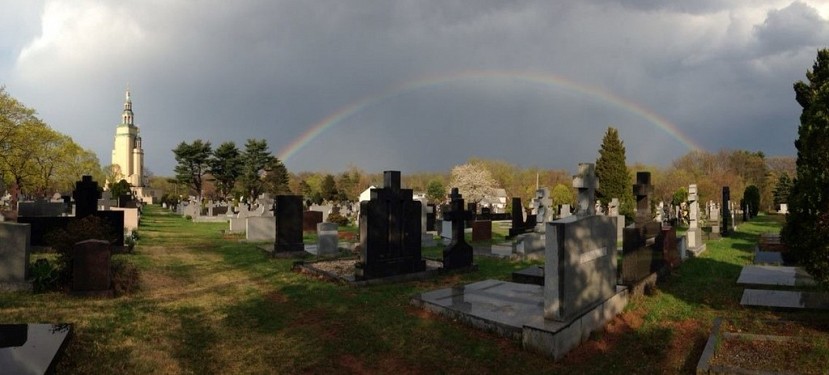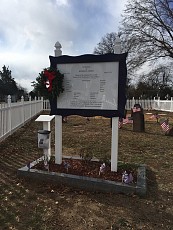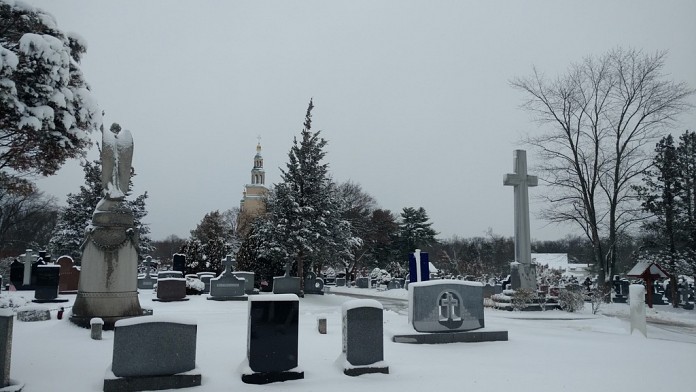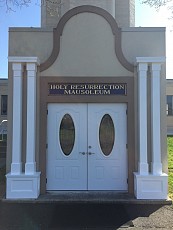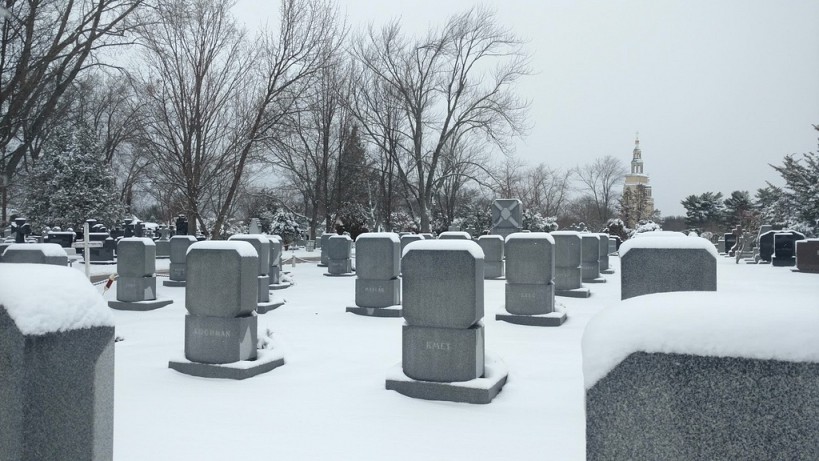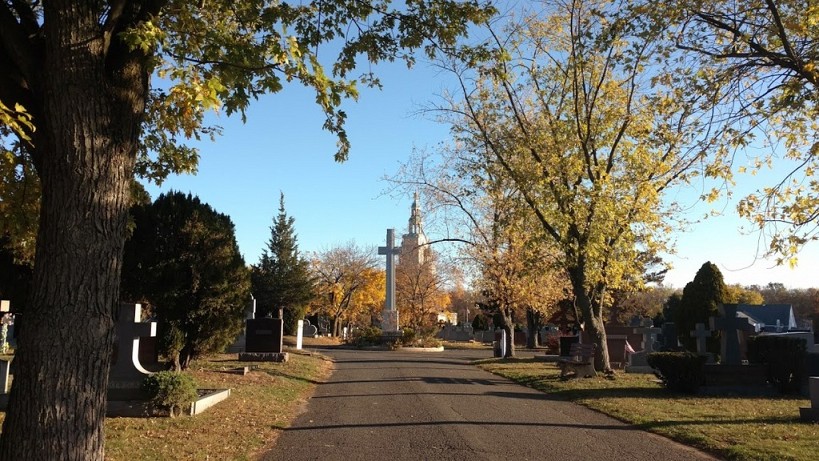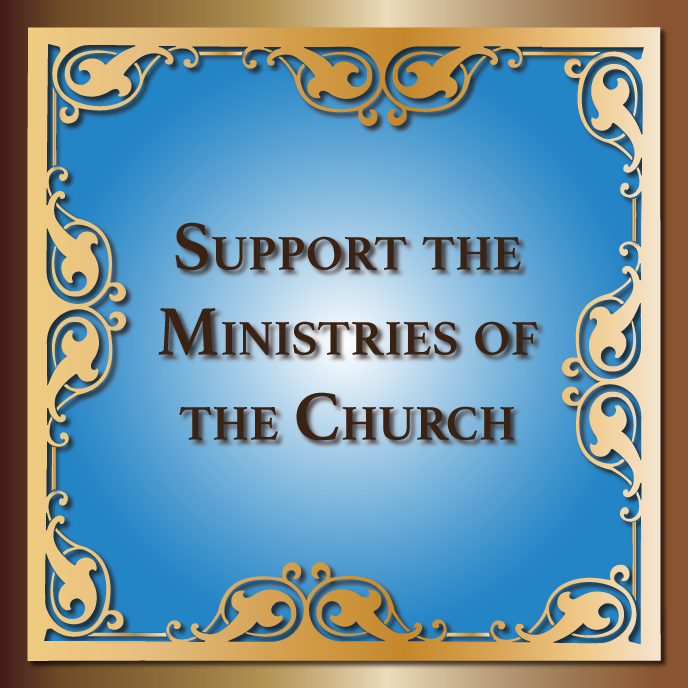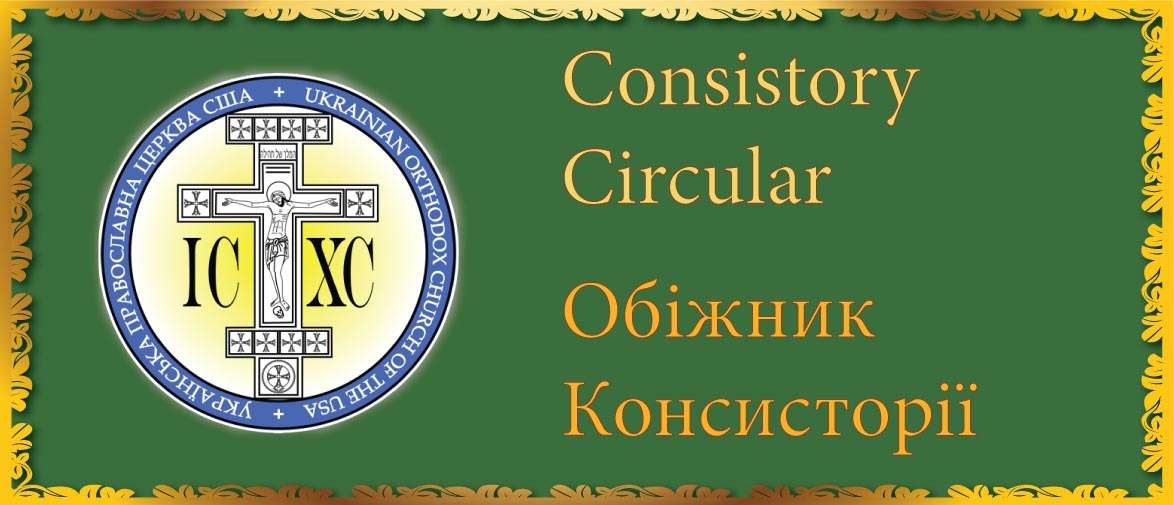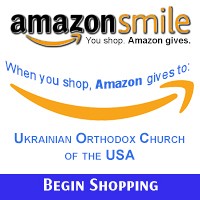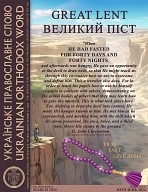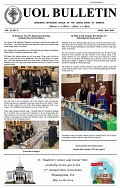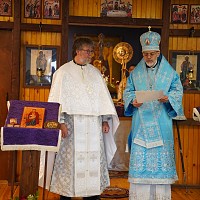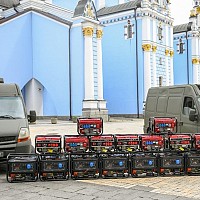St. Andrew Cemetery is located behind St. Andrew Memorial Church on the territory of the Metropolia Center in South Bound Brook/Somerset, New Jersey. The cemetery contains the mortal remains of the Hierarchs and clergy of the church, along with poets, artists, musicians, architects, doctors, lawyers, teachers and men and women of all professions, all of whom await their own resurrection to eternal life.
The idea of creating a cemetery at the Center of the Ukrainian Orthodox Church of the USA was launched three years after the church acquired the estate originally owned by the family of Heinrich Fisher, an American patriot, who was most known for returning home with a signed copy of the Declaration of Independence and read it to the inhabitants of the town.
Creating a cemetery at the Metropolia Center in South Bound Brook was made possible due to the already established small family cemetery of the original owner of the estate, Heinrich Fisher. This family graveyard, some with illegible markers, is currently segreated by a white fence and historical marker designating the plot. It is maintained and preserved by the Metropolia Center Administration and Ukrainian History and Education Center.
Learn more about the Heinrich Fisher Estate here or learn about the historic graveyard here.
The desire to create the Cemetery dates back to 1942, when then Bishop Mstyslav (Patriarch Mstyslav of Blessed Memory), on behalf of Archbishop Nikanor of Ukrainian Autocephalous Orthodox Church, embarked on a missionary trip to the Left Bank of Ukraine following his ordination. Visiting his native home of Poltava, Bishop Mstyslav saw destroyed or completely eliminated cemeteries, and found that it was impossible to find the graves of well-known Ukrainians. At that point Bishop Mstyslav decided that when fate gives him the opportunity, he will take care of creating a place of eternal rest for all deceased Ukrainians.
History of the Cemetery covers a little more than sixty years, but it was a time of never ending efforts to create and maintain this place of eternal rest for many children of the Ukrainian nation. In June 1951, the Church Council (now the Metropolia Council) approved the plan to purchase chosen possession, which had 57 acres, 3 dwelling houses, auxiliary buildings, a pond and a large meadow. The following year, there was a dedication of newly acquired estate. The faithful – not only from America but also from other countries – gave generous donations to help pay off for the estate. Two years later, on May 1, 1953, the decision was made by Consistory to start establishing on the property a Ukrainian Orthodox cemetery. This had started a long-term process with state institutions, and only in 1954 received approval for allotment for the cemetery, 15 acres of land.
On September 3, 1954, Metropolitan Ioan, Primate of the Ukrainian Orthodox Church of the USA, solemnly consecrated St. Andrew Cemetery. Soon after, the first grave plots were established. For the next five years, internment in the new cemetery was slow, but an increase in burials around the 1960s, created a need to expland the original cemetery plot. At this point, it was necessary to level all the grounds of the Center and to add additional roads. To obtain necessary funds to finish the project, the plots at the cemetery were sold in advance. Today, the cemetery has become a major burial place, which stretches from St. Andrew Memorial Church unto the end of Metropolia grounds, where a major freeway was built.
The Cemetery in South Bound Brook, NJ holds a special connection with the purpose of St. Andrew Memorial Church. St. Andrew Memorial Church was named "Memorial Church" for a special reason that it serves as a commemorative memorial as well as a temple of God. It was built as a symbolic tombstone over millions of unknown graves of those who died in the struggle for their faith, their Church, their people, their Homeland; they died not only on the fields of glory in the armed contests - they also ended life being tortured in concentration camps, prisons, even in their home villages, dying during the Great Famine, in which Moscow was destroying Ukraine and the innocent victims of war.
The Cemetery also contains a Mausoleum, which is located under St. Andrew Memorial Church. The Holy Resurrection Mausoleum was designed by then Archbishop Mstyslav and architect Yurij Kodak-Vasylchenko to be a final resting place for active members of Christ’s Church as leaders of the Ukrainian community. In 1965, the Mausoleum “temporarily” became the home of the Ukrainian Orthodox Church Museum for 35 years. The Museum collection has since been relocated and waiting a final home in the under-construction Ukrainian History and Education Center on the Metropolia grounds. After the transfer of the Museum, the completion of the mausoleum could take place. Construction began in December 2000 and the Holy Resurrection Mausoleum was officially opened and dedicate on St. Thomas Sunday, 22 April 2001 by His Beatitude Metropolitan Constantine and Archbishops Antony and Vsevelod.
The crypt of His Holiness Patriarch Mstyslav I, the first Patriarch of Kyiv and all-Ukraine of the Ukrainian Autocephalous Orthodox Church, is located at the center of the Mausoleum beneath the altar and Chapel he was largely responsible for building. The crypt was blessed on June 11, 1994, one year after his repose. There is a small exhibit of his life in the rooms around the crypt.
St. Andrew Cemetery united all who had died in different parts of the world but of Ukraine heritage and to those who were born outside the homeland. Here are the graves of great people – of different stratum, origins, faith, different beliefs. Among them - the graves of many prominent people: bishops, political leaders, soldiers, cultural figures - and those that their names make our nation to be proud of them. Here are, thousands of those who worked quietly for the history throughout their life, for the good and glory of the nation. For them is the same memory in our grateful hearts and the same mercy of our Lord in eternal life. The names of all those buried will be included in the Cemetery's "commemorative book", on which the process has already been started.
The cemetery is divided by the main road and planted trees, which over three and a half decades have grown and created an atmosphere of comfort and tranquility. On both sides of the road in straight rows are the monuments. It manifested interesting feature of human psychology: even those who through the time of their life had refused from many things, did not stint to perpetuate their memory or of their relatives, they often did put very precious monuments. Unlimited variety of ideas, symbols, poetry, showing respectful love for the dead, sorrow of the soul, hope to reunite in the eternal life...
After the first three sections of the cemetery main road expands and becomes a circular platform in the center of which stands a white granite cross with a height of almost ten meters. The memorial-cross is an impressive monument commemorating the victims of the genocidal famine created by Josepf Stalin and his Communist regiment in Ukraine during 1932-33. The cross was erected in memory of the fighters for freedom of Ukraine. The cross was designed by the famous Ukrainian artist Petro Cholodny, Jr. On the cross, there is engraved the state coats of arms of Ukraine and the insignia of Ukrainian army. At the foot of the Cross lays the original plate from the grave of Chief Otaman Symon Petliura, which was transported from Paris to South Bound Brook in 1970.
St. Andrew Cemetery each year attracts thousands of Ukrainians on the first Sunday after Easter-St. Thomas Sunday-for the traditional Pilgrimage (Provodu) in commemoration of the deceased. Provodu here, are example of how it was in the major religious and spiritual centers in Ukraine, such as Kiev-Pecherska Lavra and Pochayiv Lavra. On the morning of St. Thomas Sunday, a Divine Liturgy is served at St. Andrew Memorial Church, followed by a solemn procession to the Memorial Cross located at the center of the Cemetery. The Gospel, cross, banners are carried by the Altar servers, who lead the procession, followed by members of the clergy, and then the faithful. All gather around the Memorial Cross for a Memorial Service for the souls of the departed victims of the Holodomor, Soviet repressions, Chornobyl disaster and all those who gave their lives for the freedom and indpendence of Ukraine and the United States of America Following this, the gathered pilgrims then each visit the graves of their loved ones, relatives and friends for their personal Memorial Services, cleaning and decorating, and picnic.
St. Andrew Memorial Cemetery includes many members of the Orthodox clergy. At the front, immediately behind the Memorial Church, are are buried:
- 12 Hierarchs of the Ukrainian Orthodox Church of the USA and Diaspora: Patriarch and Metropolitan Mstyslav (Skrypnyk), Metropolitan Ioan (Teodorovich), Metropolitan Andrew (Kuschak), Archbishop Volodymyr (Malec), Bishop Alexander (Novytsky), Bishop Volodymyr (Hay), Bishop Paisij (Iwaschuk), Archbishop Iov (Skakalskyj), Archbiship Vsevelod (Majdanski), Archbishop Ihor (Huba), Archbishop Orest (Ivaniuk), Archbishop Wolodymyr (Didowych)
- Members of the clergy, among them are the ones who established Orthodox church life in the United States: Fathers Petro Bilona, Lev Veselovsky, Volodymyr Kaskova, Volodymyr Kolodnytsky, Dmitro Leshchyshyn, Hryhoriy Pavlovsky, Hruhoriy Pipuka
- Clergy of the "newer" emigration from 40s and 50s, Fathers Fedir Biletsky, Vasyl Varvariv, Leonid Dolinsky, Mykola Liashchuk, Oleksa Potulnytskyy, Fedot Shpachenko and many other pastors
Here at the cemetery in South Bound Brook rests notable political figures in Ukrainian history:
- Olena Chehivska, wife of the ideologist and evangelist of UAOC Volodymyr Chehovsky, who died in the Siberian prison
- Presidents of Ukrainian National Republic Andriy Livytsky and Stepan Vytvytsky
- Prime Minister Borys Martos of UNR
- Head of Ukrainian National Council Boris Ivanytskiy
- Minister of Post and Telegraphs of UNR Ivan Palyvoda
- Political leaders Dmytro Dontsov, Denis Kvitkovsky, Oleg Shtulya
- Commanders of the Ukrainian liberation movement general-lieutenant Alexandr Zahrodsky, general Pavlo Shandruk, colonel Petro Dyachenko
- Otaman Polissa Sich Taras Bulba-Borovets
- Head of the Ukrainian Helsinki Group general Petro Grigorenko
- and many other notable public figures, including Boris Rzhepetsky and Alexander Semeniuk
Ukrainian cultural leaders and artists are also buried at St. Andrew Cemetery including:
- Writers and poets Anatol Hak, Halyna Zhyrba, Lyudmila Kovalenko-Ivchenko, Bogdan Kravtsiv, Alexandr Lototsky, Oksana Lyaturynska, Evhen Malanyuk, Oleksa Stefanovich
- Composer Mykola Fomenko
- Composer and longtime choir director of Ukrainian Bandurist Chorus Hryhoriy Kytasty
- Artists Vasyl Krichevsky, Sergiy Litvinenko, Michaylo Mikhalevich, Mykola Mukhin
- Art historians and architects Oleksa Povstenko and Volodymyr Sichynsky
- First chairman of the Ukrainian Academy of Science in the United States Michaylo Vyetuhiv
- Longtime rector of the Ukrainian Institute of Technology and Economics Viktor Domanytskyy
- Literary scholar and archivist Volodymyr Miyakovskyy
- and other journalists, publishers, engineers, doctors, lawyers, teachers, entrepreneurs, cooperators and hundreds of ordinary workers
Cemetery Hours
The cemetery is open from dawn to dusk every day of the year. No visitation is permitted after dark.
The cemetery office is open 9 am to 5 pm Monday through Friday except Holy Days or civil holidays.
Cemetery Rules & Regulations, click here.
To contact the Cemetery Office,
call Rev. Vasyl Shak at 732-356-0090
